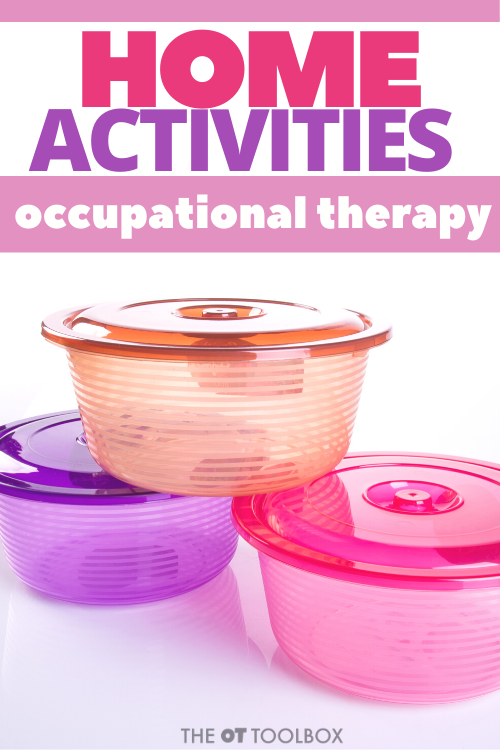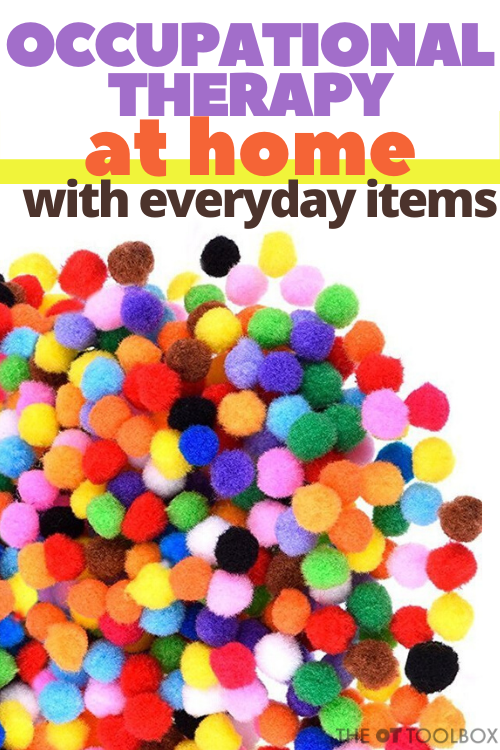Play using household items is one thing that parents are really seeking out these past few weeks. Therapists know the power of play. Likewise, occupational therapy activities using household items like kitchen items, spray bottles, recycled items and other everyday items are very useful in OT home programs. Here are ways to play and build skills with everyday items you’ve already got in the home.
I don’t know about you but I can not keep going to the store to buy things for my kids to do. As a mom and an Occupational Therapist, I want my kids to learn, have fun and gain skills from what they are playing with. If I take a minute, sit back and look around my house I have found that there is a variety of items I already have that can be used for play. Here are over 31 ways to play and learn at home with free materials (using things you already have at home).

Why is play important?
Play is such a vital component in a child development. Not only is it fun, but it allows your child to develop cogitative, physical and emotional skills. Play is how the child interacts with the world around them. It promotes language skills and interaction between others. Play builds the child’s imaginative skills. A child can learn to play with everyday objects and turn it into something else. This is seen when a child uses a car as a phone or a stick at a wand. To learn more check out this article on the, Incredible Power of Play.
Stages of play
There are different stages of play depending on your child’s age. Mildred Parten Newhall was a sociologist who came up with different stages of play. There are 6 stages of play in which a child will fall into based upon their age.
- Unoccupied (play) –Infant – when your child is observing. Learning about their environment but not participating in it yet. If you want ideas on how to play with your baby check out, Baby Play.
- Solitary (independent) play – 2-3 year olds. when your child is solely focused on the activity they are doing and is not aware of what others are playing with.
- Onlooker play (behavior) – 2-3 year olds. when your child watches others play, may make comments, but does not join in.
- Parallel play (adjacent play, social coaction) – 2 ½-4 year old- when your child may play next to a peer, imitate what they are doing, but they are still playing with items separately.
- Associative play – 3-4 years. when your child engages with others in a mutual activity but not with a common goal.
- Cooperative play –4 ½ -6 years old- when your child engages with other children, it is organized, children have assigned roles.
*Information above has been adapted from Mildred Parten’s stage of play.
It is important to know the different stages of play that your child is in. This will help to tailor activities for them. But also you can also give your child an object and just see what they do with it. The following are everyday household items that can promote imaginative play, dexterity, social skills and cognitive skills. If you would like more ideas on household items to use to help with different grasps, check out this article, WORK ON TRIPOD GRASP (AND PENCIL GRASP) WITH EVERYDAY ITEMS

Ideas for play and OT home programs with everyday household items
Painters tape
Place tape on a high chair or table in long strips and let child pull it off
Use tape to mark of sections for a child to color or paint creating a unique picture
Place a little figurines on the bottom of the tape, attach tape to pencil and have your child rotate the pencil until the figurine is on top on the pencil
Use tape to make letters/numbers
Create a space for each child in your living room using tape to block off sections
Take small pieces of tape and place them throughout the house and have a scavenger hunt
Practice wrapping boxes using wrapping paper and tape
Plastic containers
Have your child match up the different sized lids to the containers
Use the containers to make a sensory bin- fill with rice, beans, kinetic sand, cotton balls, water beads, or any item you want. Hide toys in the materials, have tongs and measuring cups to pour and scoop.
Place different colors of construction paper on the bottoms of the containers and have your child go around the house and place matching household items based on their color into the correct colored container.
Place paper on bottom inside the container, tape it down, squirt paint onto the paper and roll a marble back and forth making a neat design.
Cut slits into the lid of the containers. You can then have your child place popsicle sticks, coins, pipe cleaners, into the slits.
Large Legos
Place the legos upside down. Have your child use tongs to place colored pom poms into the holes on the bottom of the legos. They can even work on color matching this way.
Take a picture, cut it into pieces and tape the pictures to the legos. Then your child can form the picture again by putting the legos together, like a puzzle.
Place different letters on the legos and have your child work on building their names
Work on replicating patters. You make a tower then have them make a tower. You make a bridge and then have them make a bridge. See if they can replicate when you have created.
Place legos in paint and let them use it as a stamp
Push legos into playdough to make a design ( ex. A road for their car).
Spray bottle
Have your chld spray the plants inside and outside your house to water them.
Color a coffee filter with markers, have your child spray it and watch the colors run off
Use a spray bottle in the bathtub. Bring in toys, lather them with soap and have your child spray them off
Draw on the sidewalk with chalk and have your child “clean the sidewalk” by spraying water
Place a few drops of food coloring into spray bottle, add water, shake and have your child spray a piece of white paper to make a colorful picture.
Play in the kitchen
There are so many ways to play in the kitchen that help children develop fine motor skills, explore the senses, improve eye-hand coordination, and develop motor planning skills.
Try these 4 ways to play with kitchen items AND develop fine motor skills:

Hope you find these ideas helpful and easy to do. As you have read there are many different ways to play with everyday item. Have fun and see what creative things your child comes up with.
More play with household items

About Christina: Christina Komaniecki is a school based Occupational Therapist. I graduated from Governors State University with a master’s in occupational therapy. I have been working in the pediatric setting for almost 6 years and have worked in early intervention, outpatient pediatrics, inpatient pediatrics, day rehab, private clinic and schools. My passion is working with children and I love to see them learn new things and grow. I love my two little girls, family, yoga and going on long walks.






